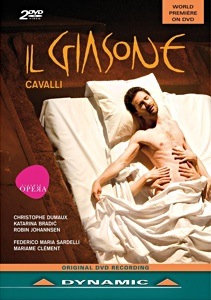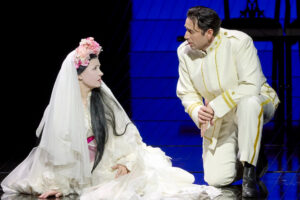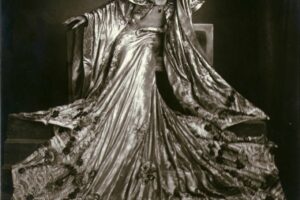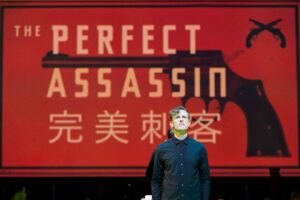
Francesco Cavalli’s 1649 opera Il Giasone (Jason) was virtually a model of the many conventions that had come to be expected in Venetian public opera in the seventeenth century. This romantic/buffo re-telling of Jason’s seeking of the Golden Fleece (and his romancing of the rival queens Medea and Hypsipyle) follows the standard recitative/aria format and contains such popular conventions as dances concluding the first two acts; comic servant scenes; military, sleep, and invocation scenes, one mad scene, various lament arias, and at last the happy ending finishing with a love duet.
The Vlaamse Opera of Antwerp/Ghent produced what it refers to as the “modern times premiere” of Il Giasone, and it was captured on DVD in performances from May 16-20, 2010. Director Mariame Clement has created an interesting, if only partially successful production, with some singers playing multiple roles. The set is mainly industrial chic with no specific sense of place; costumes are from a variety of periods and styles. While colorful and inventive, the production seems rather too clever for its own good.
Both musically and dramatically, the best moments of this performance are in the more languorous, sensual scenes. After a brief prologue where Apollo and Cupid debate which Queen Jason will marry, we come to a notable example. A door opens to a sunken bed, where a virtually nude Jason (countertenor Christophe Dumaux) is being caressed all over his body by two pairs of hands, representing his two lovers. He sings the very sensual aria “Delizie, contenti” with an almost orgasmic longing. Equally effective is Medea’s first aria “Se dardo pungente”, also sung from the bed with equal passion and desire.
Alas, when the plot thickens the opera seems to go off the tracks into extended debates about the nature of love and marriage and passion vs. duty. Poor abandoned Hypsipyle (Robin Johannsen) flings herself about the stage, desperately seeking to enlist all who will listen in her efforts to snare Jason away from Medea; her various laments du harpsichord quickly begin to sound alike and become tiresome. But most tiresome of all are the comic elements in this production.
Apparently the Venetian audience found great humor in the character of Demo, a stuttering hunchback, but I doubt a modern audience does, despite the best efforts of tenor Filippo Adami, who strives mightily but unsuccessfully to bring some humanity to the character. The comic servants Delfa (Yaniv D’Or in 1950’s drag) and Besso (bass Josef Wagner) have their amusing moments, but are mostly stuck with the director’s ham-fisted attempts at farce.
By far the most exciting and interesting music in the opera is in Medea’s invocation scene at the end of Act One, where Cavalli shifts gears into music that expresses the magical, demonic forces that Medea calls up to aid Jason in finding the Golden Fleece. “Dell’antro Magico” is a welcome relief from the harpsichord-and-strings music, and even reminds a bit of Ulrica in Un ballo in maschera coming some two centuries later.
The singing is a mixed bag. The androgynous, whisper-slim Dumaux in the title role has an absolutely beautiful countertenor, even of tone and capable of both sensuality and bravado. But it is mezzo-soprano Katarina Bradic as Medea that makes the strongest impression. A dead ringer for the actress Minnie Driver, Bradic portrays Medea’s shifting moods with power and subtlety. She is a splendid actress and a most pleasing singer, and I expect we will soon be hearing her in major venues.
Soprano Johannsen brings a limpidly lovely voice to Hypsipyle, but she wears a same rather vapid smile no matter what the subject of her music. Andrew Ashwin as Hercules and Oreste (in a kilt!) is a commanding presence but simply doesn’t have the low notes for either role.
Conductor Federico Maria Sardelli leads the Symphony Orchestra of Vlaamse Opera in a spirited reading of Cavalli’s score, shifting successfully between the dark and light elements of the opera. Sardelli also is a player—he displays fine skill on the sopranino recorder.
Fans of baroque opera will likely be most pleased to have Il Giasone, even in this rather peculiar production, being produced after a long absence. For me, Cavalli’s music is a pleasant, if somewhat repetitive, diversion. Moments that thrill (like the invocation scene), however, are few and far between. Still, the music of brooding eroticism that infuses this score is a rare find in a seventeenth century work. One wonders if Vlaamse Opera has begun a Cavalli “boomlet” on the world’s opera stages.

























Comments